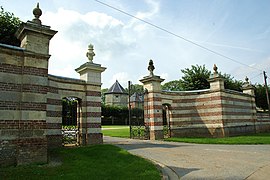Marieux | |
|---|---|
 The entrance to the chateau in Marieux | |
| Coordinates: 50°06′23″N 2°26′37″E / 50.1064°N 2.4436°E | |
| Country | France |
| Region | Hauts-de-France |
| Department | Somme |
| Arrondissement | Péronne |
| Canton | Albert |
| Intercommunality | Pays du Coquelicot |
| Government | |
| • Mayor (2020–2026) | Hervé Bayard[1] |
| Area 1 | 4.07 km2 (1.57 sq mi) |
| Population (2021)[2] | 133 |
| • Density | 33/km2 (85/sq mi) |
| Time zone | UTC+01:00 (CET) |
| • Summer (DST) | UTC+02:00 (CEST) |
| INSEE/Postal code | 80514 /80560 |
| Elevation | 75–133 m (246–436 ft) (avg. 102 m or 335 ft) |
| 1 French Land Register data, which excludes lakes, ponds, glaciers > 1 km2 (0.386 sq mi or 247 acres) and river estuaries. | |
Marieux (French pronunciation: [maʁjø]) is a commune in the Somme department in Hauts-de-France in northern France.
Geography
[edit]Marieux is situated on the D11 road, some 20 miles (32 km) north of Amiens.
History
[edit]The château was built in 1777 and is still owned and occupied by the same family today. Marieux is on the once strategically important and well-protected Roman road leading from Amiens to the English Channel and Britain.
During the First World War, it was British army headquarters for this part of the western front. On 25 October 1915, George V lunched here at the château with French Président Poincaré and the Chiefs-of-Staff of the French and British armies.
Population
[edit]| Year | Pop. | ±% p.a. |
|---|---|---|
| 1968 | 115 | — |
| 1975 | 117 | +0.25% |
| 1982 | 113 | −0.50% |
| 1990 | 92 | −2.54% |
| 1999 | 82 | −1.27% |
| 2007 | 107 | +3.38% |
| 2012 | 111 | +0.74% |
| 2017 | 122 | +1.91% |
| Source: INSEE[3] | ||
See also
[edit]References
[edit]- ^ "Répertoire national des élus: les maires". data.gouv.fr, Plateforme ouverte des données publiques françaises (in French). 2 December 2020.
- ^ "Populations légales 2021" (in French). The National Institute of Statistics and Economic Studies. 28 December 2023.
- ^ Population en historique depuis 1968, INSEE
Wikimedia Commons has media related to Marieux.


